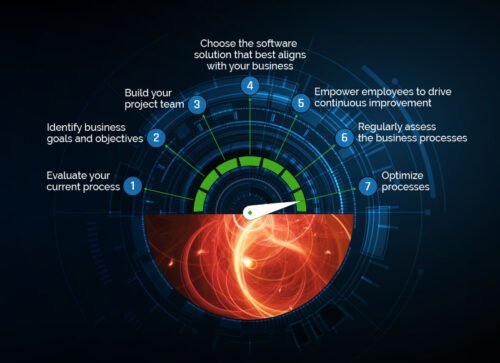7 Steps to Jump-start Your Digital Transformation
 Today digital transformation is top of mind for many manufacturers, as they are forced to compete with novel, disruptive technologies and navigate the new normal of pandemics, part shortages, and other unforeseen events. Companies are reinventing their business practices to mitigate these ongoing disruptions and maintain a competitive advantage. By embracing new digital technologies or software solutions, manufacturers can improve supply chain resilience, enhance collaboration across dispersed teams, boost operational efficiency, and accelerate time to market.
Today digital transformation is top of mind for many manufacturers, as they are forced to compete with novel, disruptive technologies and navigate the new normal of pandemics, part shortages, and other unforeseen events. Companies are reinventing their business practices to mitigate these ongoing disruptions and maintain a competitive advantage. By embracing new digital technologies or software solutions, manufacturers can improve supply chain resilience, enhance collaboration across dispersed teams, boost operational efficiency, and accelerate time to market.
According to a McKinsey survey1, more than 8 in 10 respondents reported that their organizations have undertaken a digital transformation initiative. However, despite their best efforts, realizing the program’s full potential has been elusive.
Here we discuss some of the roadblocks that often prevent companies from achieving digital adoption success. We also highlight key steps that you can take to get your digital program off to a good start, including the adoption of a cloud-based product lifecycle management (PLM) or quality management system (QMS) software solution.
Common Barriers to Digital Transformation
There are several factors that can create barriers for companies as they embark on a digital transformation journey.
Legacy Systems
Undertaking a true transformation means letting go of legacy systems. This is especially difficult for manufacturers that are accustomed to using manual or document-based systems to manage their product development and quality processes. Because these legacy systems have accumulated many years of data, manufacturers are reluctant to make the switch to digital in fear of losing critical product information.
Lack of Planning
Embracing the concept of digital isn’t enough to make it a reality. From the start, businesses must have a clear vision and plan for what they want to accomplish throughout the endeavor. This involves setting realistic goals and establishing proper metrics to monitor progress.
Lack of Employee Engagement
Employees often work in siloed environments where cross-functional communication and collaboration are lacking. Teams are not encouraged to work together and share their ideas on how digitization can support better processes and customer experiences. Without full commitment and buy-in from the entire organization, digital transformation programs are destined to fail.
Cybersecurity
Cybersecurity risks can greatly impede organizations’ transformation efforts. As companies consider the Cloud and other digital platforms, the proper security controls and monitoring systems must be in place to detect and prevent possible cyberattacks.
Budget
Sometimes companies forego software systems due to the unwillingness of senior management to allocate budget toward the initiative. This often stems from their focus on protecting the core business and meeting short-term goals as opposed to looking to the future to drive cultural change and innovation.
How to Jump-start Your Digital Transformation
Despite the obstacles, companies can achieve success if they have a simple and clear digital transformation strategy in place.
 To get your program off to the right start, follow these seven steps:
To get your program off to the right start, follow these seven steps:
1. Evaluate your current product development or launch processes.
Complete a cross-functional audit of your current processes to identify gaps and areas for improvement. Soliciting employee feedback from the outset will foster an environment of inclusion and encourage increased engagement throughout the digital transformation process.
2. Identify business goals and objectives.
Set realistic goals and objectives based on the findings from your audit. Keep in mind that you don’t have to accomplish everything at once. Start by completing small projects and gradually expand as your program gains momentum.
3. Build your project team.
Your team should include key stakeholders from across the organization, including:
- Engineering
- Procurement
- Manufacturing
- Operations (manufacturing supply chain teams)
- Quality/regulatory affairs
- Customer support
- Executive sponsor that is responsible for getting products to market
4. Choose the software solution and vendor that best aligns with your business needs.
Buying the right software or technology to support your product development efforts involves many steps, from capturing your business requirements and choosing a vendor to building a financial case. When evaluating different solutions, it is important to consider your total cost of ownership (TCO) which includes not only upfront software costs—but costs associated with ongoing maintenance, new releases, and customer support.
5. Empower employees to drive continuous improvement.
Encourage and reward employees for contributing new ideas that can help improve product development processes and bring new value to customers. Also provide management with the necessary tools to monitor operational performance and make adjustments.
6. Regularly assess your business processes.
Evaluate the actual performance of your product development software against the targeted business objectives. Key metrics to measure include time to market, reduced costs, and customer satisfaction.
7. Optimize processes based on metrics and findings.
By evaluating your performance outcomes, your team will have a clear roadmap for making process and product improvements that drive customer satisfaction and revenue growth.
Cloud Technology Accelerates Digital Transformation
A key driver of a successful digital transformation is an organization’s ability to quickly deploy the new technology. Cloud-native (multi-tenant) PLM and QMS solutions that are sold under a software-as-a-service (SaaS) subscription model are designed for fast deployment—eliminating the need for hardware, software, virtual private networks (VPNs), and other extensive IT infrastructure. The advanced integration capabilities of the QMS and PLM software also make it easy for companies to migrate their legacy product data to the Cloud.
PLM and digital transformation are crucial for companies to stay competitive. Modern PLM systems streamline product development, enhance collaboration, and utilize AI and data analytics to optimize processes and improve decision-making, driving innovation and efficiency in today’s fast-paced business environment.
Once these cloud-based systems are deployed, continuous enhancements are provided by the vendor, eliminating the traditional costs associated with upgrades and ongoing maintenance. In addition, the cybersecurity issues that are often encountered with on-premises and single-tenant SaaS platforms are nonexistent with multi-tenant SaaS solutions through the use of a robust multilayered security model.
To learn more about how cloud-based PLM and QMS software solutions can accelerate your digital transformation and help you thrive, read this white paper.
References


